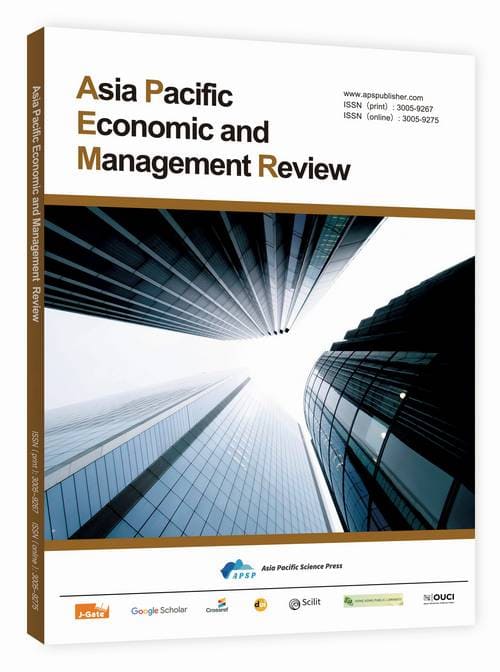Optimal Product Pricing and Recovery Strategies in a Two-period Model for Manufacturers with Core Classification and Trade-In-for-New/Reman Policies
DOI:
https://doi.org/10.62177/apemr.v2i5.651Keywords:
Product Segmentation, Trade-in-for-New, Trade-in-for-Reman, Pricing Strategy, RemanufacturingAbstract
Motivated by the recent policy initiative of the Central Financial and Economic Affairs Commission to promote a new round of equipment upgrading and consumer-goods trade-in programs, we develop a two-period game-theoretic model for a manufacturer endowed with remanufacturing capability. In period 1, the market is partitioned into new and remanufactured products, and the initial market structure is determined by their respective demand shares. In period 2, consumers’ trade-in/-for-remanufacturing behavior is disentangled; utility theory is employed to derive demand functions under alternative scenarios. The manufacturer then chooses the sales prices of both new and remanufactured products together with the buy-back price of used new products so as to maximize its total profit. Key findings are as follows. (1) The new-product demand share, the trade-in discount for remanufactured items, and the product’s circular value are the three pivotal drivers of pricing strategy. In particular, when the new-product demand share is low, the circular value is high, or the remanufactured-product trade-in discount is large, the optimal buy-back price of new products equals the selling price of remanufactured products. (2) The sales prices of new/remanufactured products and the buy-back price increase with the remanufacturing trade-in discount and consumers’ perceived-value discount, decrease with the circular value, and rise with the new-product production cost. (3) The impact of the new product’s circular value on pricing depends on the market structure: only when the new-product demand share is high, the trade-in discount is low, and the circular value itself is small will an increase in circular value raise all prices. (4) Under a high remanufactured-product pricing strategy, the buy-back price is U-shaped in the new-product demand share; under a low pricing strategy it increases monotonically. (5) Manufacturer profit increases with the remanufacturing trade-in discount, the circular value, and the perceived-value discount, but decreases with the remanufacturing circular value. A lower new-product demand share and higher production cost reduce total profit; however, once the cost exceeds a critical threshold, profit rebounds. We recommend that manufacturers dynamically adjust pricing, invest in remanufacturing technology, and enhance recovery incentives. Meanwhile, governments should underpin green consumption and the circular economy through supportive policies and effective oversight.
Downloads
References
Jing, Y., & Du, P. (2021). Game analysis between manufacturers and remanufacturers under “trade-old-for-remanufactured” and “trade-old-for-new” strategies. Journal of Systems Engineering, 36(3), 339-352.
Zhu, R. J., Chen, X. J., & Dasgupta, S. (2008). Can trade-ins hurt you? Exploring the effect of a trade-in on consumers' willingness to pay for a new product. Journal of Marketing Research, 45(2), 159-170. https://doi.org/10.1509/jmkr.45.2.159 DOI: https://doi.org/10.1509/jmkr.45.2.159
Wang, Y., Hazen, B. T., et al. (2016). Consumer product knowledge and intention to purchase remanufactured products. International Journal of Production Economics, 181, 460-469. https://doi.org/10.1016/j.ijpe.2015.08.031 DOI: https://doi.org/10.1016/j.ijpe.2015.08.031
Wang, S., Wang, J., Yang, F., et al. (2020). Determinants of consumers' remanufactured products purchase intentions: Evidence from China. International Journal of Production Research, 58(8), 2368-2383. https://doi.org/10.1080/00207543.2019.1630767 DOI: https://doi.org/10.1080/00207543.2019.1630767
Wang, Y., Wiegerinck, V., Krikke, H. R., et al. (2013). Understanding the purchase intention towards remanufactured product in closed-loop supply chains: An empirical study in China. International Journal of Physical Distribution & Logistics Management, 43. https://doi.org/10.1108/IJPDLM-01-2013-0011 DOI: https://doi.org/10.1108/IJPDLM-01-2013-0011
Singhal, D., Jena, S. K., Tripathy, S., et al. (2019). Factors influencing the purchase intention of consumers towards remanufactured products: A systematic review and meta-analysis. International Journal of Production Research, 57(23), 7289-7299. https://doi.org/10.1080/00207543.2019.1598590 DOI: https://doi.org/10.1080/00207543.2019.1598590
Khor, K. S., Hazen, B. T., et al. (2017). Remanufactured products purchase intentions and behaviour: Evidence from Malaysia. International Journal of Production Research, 55(8), 2149-2162. https://doi.org/10.1080/00207543.2016.1194534 DOI: https://doi.org/10.1080/00207543.2016.1194534
Lv, J., Liu, X., Cheng, S., et al. (2021). The impact of remanufactured products’ similarity on purchase intention of new products. Sustainability, 13(4), 1825. https://doi.org/10.3390/su13041825 DOI: https://doi.org/10.3390/su13041825
Alyahya, M., Agag, G., Aliedan, M., et al. (2023). A sustainable step forward: Understanding factors affecting customers’ behaviour to purchase remanufactured products. Journal of Retailing and Consumer Services, 70, 103172. https://doi.org/10.1016/j.jretconser.2022.103172 DOI: https://doi.org/10.1016/j.jretconser.2022.103172
Christensen, L. R., Manser, M. E., et al. (1977). Estimating U.S. consumer preferences for meat with a flexible utility function. Journal of Econometrics, 5(1), 37-53. https://doi.org/10.1016/0304-4076(77)90033-1 DOI: https://doi.org/10.1016/0304-4076(77)90033-1
Wang, Y., Xin, B., Wang, Z., et al. (2019). Managing supplier-manufacturer closed-loop supply chain considering product design and take-back legislation. International Journal of Environmental Research and Public Health, 16(4), E623. https://doi.org/10.3390/ijerph16040623 DOI: https://doi.org/10.3390/ijerph16040623
Esenduran, G., Kemahlıoğlu-Ziya, E., Swaminathan, J. M., et al. (2016). Take-back legislation: Consequences for remanufacturing and environment. Decision Sciences, 47(2), 219-256. https://doi.org/10.1111/deci.12174 DOI: https://doi.org/10.1111/deci.12174
Dong, C., Lei, Y., Liu, Q., et al. (2023). (Un)conditional collection policies on used products with strategic customers. Production and Operations Management, 32(1), 82-97. https://doi.org/10.1111/poms.13826 DOI: https://doi.org/10.1111/poms.13826
Sun, X., Zhou, Y., Li, Y., et al. (2020). Differentiation competition between new and remanufactured products considering third-party remanufacturing. Journal of the Operational Research Society, 71(1), 161-180. https://doi.org/10.1080/01605682.2018.1512843 DOI: https://doi.org/10.1080/01605682.2018.1512843
Guide, J. V. D. R., Li, J., et al. (2010). The potential for cannibalization of new products sales by remanufactured products. Decision Sciences, 41(3), 547-572. https://doi.org/10.1111/j.1540-5915.2010.00280.x DOI: https://doi.org/10.1111/j.1540-5915.2010.00280.x
Abbey, J. D., Blackburn, J. D., Guide, V. D. R., et al. (2015). Optimal pricing for new and remanufactured products. Journal of Operations Management, 36, 130-146. https://doi.org/10.1016/j.jom.2015.03.007 DOI: https://doi.org/10.1016/j.jom.2015.03.007
Wang, B., Wang, J., et al. (2015). Price and service competition between new and remanufactured products. Mathematical Problems in Engineering, 2015, 1-18. DOI: https://doi.org/10.1155/2015/325185
Wu, C., et al. (2012). Price and service competition between new and remanufactured products in a two-echelon supply chain. International Journal of Production Economics, 140(1), 496-507. https://doi.org/10.1016/j.ijpe.2012.06.034 DOI: https://doi.org/10.1016/j.ijpe.2012.06.034
Wu, C., et al. (2012). Product-design and pricing strategies with remanufacturing. European Journal of Operational Research, 222(2), 204-215. https://doi.org/10.1016/j.ejor.2012.04.031 DOI: https://doi.org/10.1016/j.ejor.2012.04.031
Zheng, M., Shi, X., Xia, T., et al. (2021). Production and pricing decisions for new and remanufactured products with customer prejudice and accurate response. Computers & Industrial Engineering, 157, 107308. https://doi.org/10.1016/j.cie.2021.107308 DOI: https://doi.org/10.1016/j.cie.2021.107308
Guide, D., Teunter, R., Van Wassenhove, L., et al. (2003). Matching demand and supply to maximize profits from remanufacturing. Manufacturing & Service Operations Management, 5, 303-316. https://doi.org/10.1287/msom.5.4.303.24883 DOI: https://doi.org/10.1287/msom.5.4.303.24883
Bhattacharya, R., Kaur, A., et al. (2015). Allocation of external returns of different quality grades to multiple stages of a closed loop supply chain. Journal of Manufacturing Systems, 37, 692-702. https://doi.org/10.1016/j.jmsy.2015.01.004 DOI: https://doi.org/10.1016/j.jmsy.2015.01.004
Raihanian Mashhadi, A., Behdad, S., et al. (2017). Optimal sorting policies in remanufacturing systems: Application of product life-cycle data in quality grading and end-of-use recovery. Journal of Manufacturing Systems, 43, 15-24. https://doi.org/10.1016/j.jmsy.2017.02.006 DOI: https://doi.org/10.1016/j.jmsy.2017.02.006
Fan, X., Guo, X., Wang, S., et al. (2022). Optimal collection delegation strategies in a retail-/dual-channel supply chain with trade-in programs. European Journal of Operational Research, 303(2), 633-649. https://doi.org/10.1016/j.ejor.2022.02.053 DOI: https://doi.org/10.1016/j.ejor.2022.02.053
Li, Y., Wang, K., Xu, F., et al. (2022). Management of trade-in modes by recycling platforms based on consumer heterogeneity. Transportation Research Part E: Logistics and Transportation Review, 162, 102721. https://doi.org/10.1016/j.tre.2022.102721 DOI: https://doi.org/10.1016/j.tre.2022.102721
Yin, J., Xie, J., Liu, J., et al. (2017). Research on decision-making mechanism of remanufacturing with graded recycling of old parts. Shanghai Management Science, 39(3), 22-29.
van Loon, P., Van Wassenhove, L. N., et al. (2018). Assessing the economic and environmental impact of remanufacturing: A decision support tool for OEM suppliers. International Journal of Production Research, 56, 1662-1674. https://doi.org/10.1080/00207543.2017.1381820 DOI: https://doi.org/10.1080/00207543.2017.1367107
Zhang, Q., Xiao, T., et al. (2024). Incentive strategies of an e-tailer considering online reviews: Rebates or services. Electronic Commerce Research and Applications, 68, 101453. https://doi.org/10.1016/j.elerap.2024.101453 DOI: https://doi.org/10.1016/j.elerap.2024.101453
Sheldon, T. L., Dua, R., et al. (2024). The dynamic role of subsidies in promoting global electric vehicle sales. Transportation Research Part A: Policy and Practice, 187, 104173. https://doi.org/10.1016/j.tra.2024.104173 DOI: https://doi.org/10.1016/j.tra.2024.104173
Du, Z., Fan, Z., Sun, F., et al. (2023). Live streaming sales: Streamer type choice and limited sales strategy for a manufacturer. Electronic Commerce Research and Applications, 61, 101300. https://doi.org/10.1016/j.elerap.2023.101300 DOI: https://doi.org/10.1016/j.elerap.2023.101300
Wan, Y., Yang, L., Zhang, J., et al. (2024). Optimal trade-in programs for quality differentiated recycled products. Transportation Research Part E: Logistics and Transportation Review, 188, 103617. https://doi.org/10.1016/j.tre.2024.103617 DOI: https://doi.org/10.1016/j.tre.2024.103617
Xu, Y., Wang, J., Cao, K., et al. (2024). Dynamic joint strategy of channel encroachment and logistics choice considering trade-in service and strategic consumers. Transportation Research Part E: Logistics and Transportation Review, 185, 103528. https://doi.org/10.1016/j.tre.2024.103528 DOI: https://doi.org/10.1016/j.tre.2024.103528
Liu, K., Li, Q., Zhang, H., et al. (2024). Trade-in strategies in closed-loop supply chain when considering manufacturer entrustment behavior and wholesale price contract. Journal of the Operational Research Society. https://doi.org/10.1080/01605682.2024.2368018 DOI: https://doi.org/10.1080/01605682.2024.2338845
Shi, P., Shi, S., et al. (2022). Analysis of manufacturers' autonomous trade-in strategies in the presence of competition from informal recyclers. Journal of Systems Engineering, 37(1), 12-22.
Wang, W., Feng, L., Chen, X., et al. (2024). Impacts of selling models: Who should offer trade-in programs in e-commerce supply chains? Transportation Research Part E: Logistics and Transportation Review, 186, 103524. https://doi.org/10.1016/j.tre.2024.103524 DOI: https://doi.org/10.1016/j.tre.2024.103524
Tang, F., Dai, Y., Ma, Z., et al. (2023). Trade-in operations under retail competition: Effects of brand loyalty. European Journal of Operational Research, 310(1), 397-414. https://doi.org/10.1016/j.ejor.2023.03.020 DOI: https://doi.org/10.1016/j.ejor.2023.03.020
Yang, G., He, B., Ma, R., et al. (2023). Self-building or cooperating with a service platform: How should a dual-channel firm implement a trade-in program? Electronic Commerce Research. https://doi.org/10.1007/s10660-023-09746-w DOI: https://doi.org/10.1007/s10660-023-09746-w
Ma, P., Gong, Y., Mirchandani, P., et al. (2020). Trade-in for remanufactured products: Pricing with double reference effects. International Journal of Production Economics, 230, 107800. https://doi.org/10.1016/j.ijpe.2020.107800 DOI: https://doi.org/10.1016/j.ijpe.2020.107800
Sun, X., Wu, Z., et al. (2020). Trade-old-for-remanufactured recycling models under different market leaders. Industrial Engineering, 23(5), 169-175.
Gao, P., Ding, X., et al. (2020). Manufacturer decision model based on “trade-old-for-remanufactured” and consumer segmentation. Systems Engineering — Theory & Practice, 40(4), 951-963.
Wan, F., Zou, W., et al. (2019). Impact of “trade-old-for-remanufactured” policy on closed-loop supply chain of end-of-life vehicle remanufacturing. Ecological Economy, 35(3), 79-86.
Han, X., Yang, Q., Shang, J., et al. (2017). Optimal strategies for trade-old-for-remanufactured programs: Receptivity, durability, and subsidy. International Journal of Production Economics, 193, 602-616. https://doi.org/10.1016/j.ijpe.2017.07.025 DOI: https://doi.org/10.1016/j.ijpe.2017.07.025
Liu, K., Li, Q., Liu, J., et al. (2024). Trade-In and Trade-Old-for-Remanufactured in Closed-Loop Supply Chain Under Different Power Structures and Government Subsidy. SAGE Open. https://doi.org/10.1177/2158244024125721 DOI: https://doi.org/10.1177/21582440241251474
Li, D., Shen, B., et al. (2024). Closed-loop supply chain management under the interaction of “trade-old-for-new” and “trade-old-for-remanufactured”. Systems Engineering, 42(6), 72-83.
Xiong, Y., Zhou, Y., Li, G., et al. (2013). Don’t forget your supplier when remanufacturing. European Journal of Operational Research, 230(1), 15-25. https://doi.org/10.1016/j.ejor.2013.03.034 DOI: https://doi.org/10.1016/j.ejor.2013.03.034
Ke, C., Yan, B., et al. (2020). Trade-in value effects of used products in remanufacturing with considering consumer purchase behavior. Journal of the Operational Research Society, 73, 608-633. https://doi.org/10.1080/01605682.2020.1783978 DOI: https://doi.org/10.1080/01605682.2020.1848362
Chen, J., Chang, C., et al. (2013). Dynamic pricing for new and remanufactured products in a closed-loop supply chain. International Journal of Production Economics, 146(1), 153-160. https://doi.org/10.1016/j.ijpe.2013.06.017 DOI: https://doi.org/10.1016/j.ijpe.2013.06.017
Wu, X., Zhou, Y., et al. (2015). Does the entry of third-party remanufacturers always hurt original equipment manufacturers? Marketing Science eJournal. DOI: https://doi.org/10.1111/deci.12194
Nie, J., Liu, J., Yuan, H., et al. (2021). Economic and environmental impacts of competitive remanufacturing under government financial intervention. Computers & Industrial Engineering, 159, 107473. https://doi.org/10.1016/j.cie.2021.107473 DOI: https://doi.org/10.1016/j.cie.2021.107473
Wang, Z., Wang, Y., Gong, Y., et al. (2024). Cooperate or not? Strategic analysis of formal and informal recyclers under different retired power battery recycling market structures. Computers & Industrial Engineering, 193, 110294. https://doi.org/10.1016/j.cie.2024.110294 DOI: https://doi.org/10.1016/j.cie.2024.110294
Li, Y., Feng, L., Govindan, K., et al. (2019). Effects of a secondary market on original equipment manufacturers’ pricing, trade-in remanufacturing, and entry decisions. European Journal of Operational Research, 279(3), 751-766. https://doi.org/10.1016/j.ejor.2019.03.039 DOI: https://doi.org/10.1016/j.ejor.2019.03.039
Zhang, Z., Ren, D., Lan, Y., et al. (2022). Price competition and blockchain adoption in retailing markets. European Journal of Operational Research, 300(2), 647-660. https://doi.org/10.1016/j.ejor.2021.08.027 DOI: https://doi.org/10.1016/j.ejor.2021.08.027
Wang, Q., Li, B., Chen, B., et al. (2021). Implication of take-back and carbon emission capacity regulations on remanufacturing in a competitive market. Journal of Cleaner Production, 325, 129231. https://doi.org/10.1016/j.jclepro.2021.129231 DOI: https://doi.org/10.1016/j.jclepro.2021.129231
Wang, X., Xu, Y., Choi, T., et al. (2024). Who should pay for the return freight in e-commerce? Platforms, retailers or consumers. International Journal of Production Economics, 277, 109375. https://doi.org/10.1016/j.ijpe.2024.109375 DOI: https://doi.org/10.1016/j.ijpe.2024.109375
Liang, Y., Liu, W., Li, K. W., et al. (2023). A co‐opetitive game analysis of platform compatibility strategies under add‐on services. Production and Operations Management, 32, 3541-3558. https://doi.org/10.1111/poms.13991 DOI: https://doi.org/10.1111/poms.14049
Ma, P., Zhou, X., et al. (2023). Financing strategies and government incentives in a competing supply chain with Trading-Old-for-Remanufactured programs. CIRP Journal of Manufacturing Science and Technology, 46, 242-263. https://doi.org/10.1016/j.cirpj.2023.08.008 DOI: https://doi.org/10.1016/j.cirpj.2023.08.008
Li, S., Zheng, B., Jia, D., et al. (2024). Optimal decisions for hybrid manufacturing and remanufacturing with trade-in program and carbon tax. Omega, 124, 103012. https://doi.org/10.1016/j.omega.2023.103012 DOI: https://doi.org/10.1016/j.omega.2023.103012
Downloads
How to Cite
Issue
Section
License
Copyright (c) 2025 Zhe Wang, Peipei Cao, Fan Xu

This work is licensed under a Creative Commons Attribution-NonCommercial 4.0 International License.
DATE
Accepted: 2025-09-29
Published: 2025-10-13

















